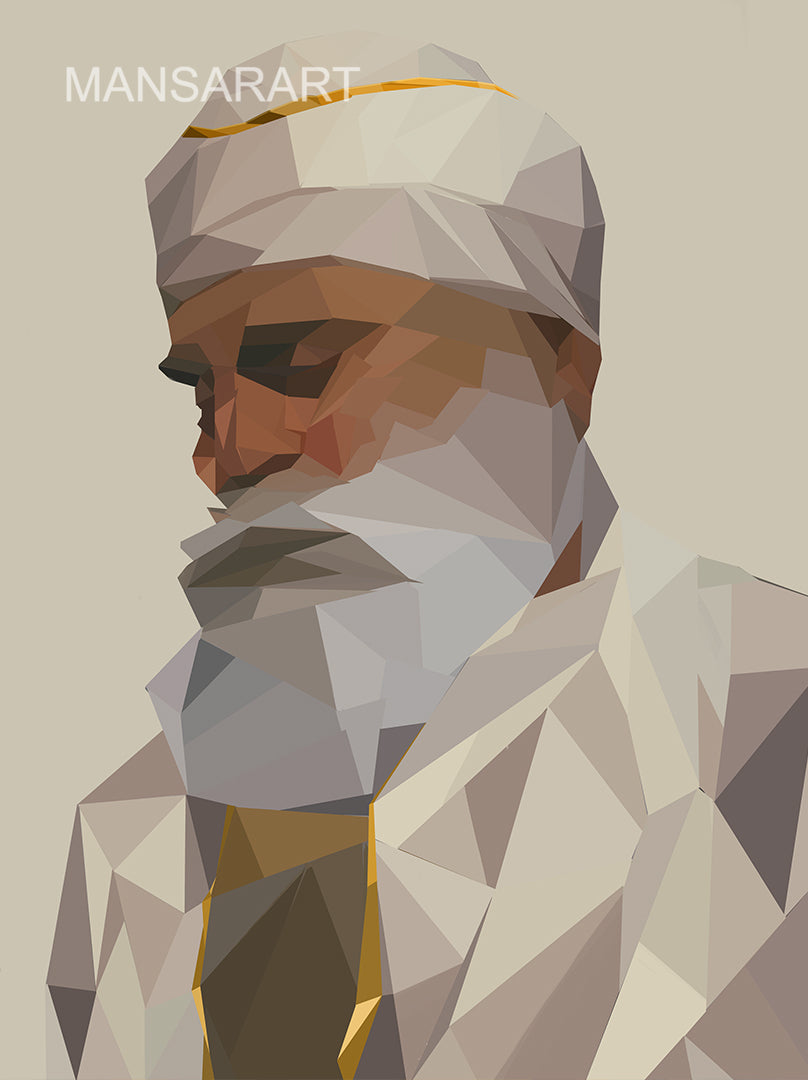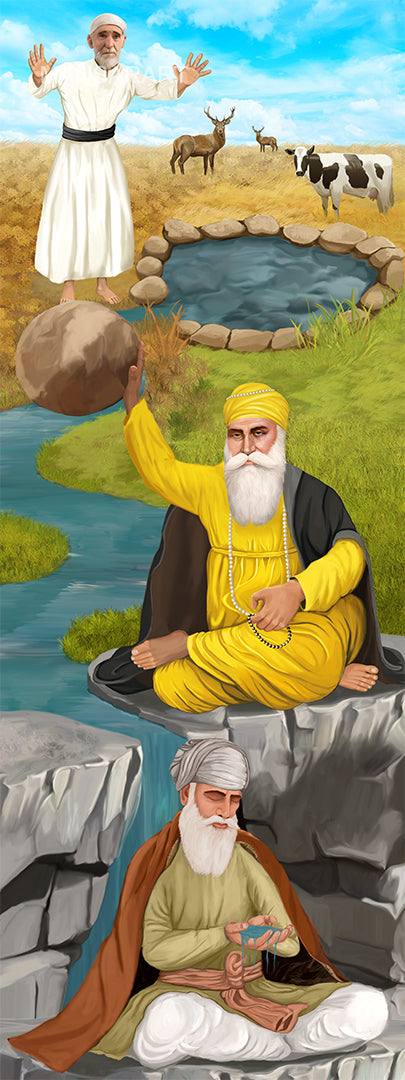Sikh Art Collection


GURU GOBIND SINGH JI : The Warrior Saint
Guru Gobind Singh ji, the tenth Guru of Sikhs, was a visionary leader, warrior, poet, and philosopher who played a pivotal role in shaping Sikh history and identity. He resisted the forced conversion of Hindus and Sikhs by Mughal rulers and fought against injustice and tyranny.
Guru Gobind Singh's teachings emphasize the unity of God, the importance of selfless service, and the duty to stand up against oppression. His life exemplifies the Sikh ideal of the Saint-Soldier (Sant-Sipahi), combining spirituality with the readiness to defend one's faith and values. Guru Gobind Singh organized the Sikh community into a martial order known as the Khalsa, characterized by a code of conduct and a commitment to defending righteousness.....

GURU GOBIND SINGH : The Sword of Righteousness
Guru Gobind Singh (1666-1708) played a pivotal role in shaping Sikhism. He founded the Khalsa in 1699, a collective body of initiated Sikhs bound by a code of conduct and devoted to the principles of Sikhism. The Khalsa was established to fight against tyranny and to protect the weak, embodying the values of bravery, equality, and justice.
The stance and the sword also symbolize empowerment. Guru Gobind Singh instilled the spirit of courage and self-reliance in his followers, encouraging them to stand up against injustice and oppression.
His face is calm yet stern, reflecting his inner peace and spiritual depth combined with the strength and determination of a warrior. His eyes often convey a sense of divine wisdom and compassion.

GURU GOBIND SINGH JI : Majestic Presence
Guru Gobind Singh Ji, the tenth Sikh Guru, is a revered figure in Sikh history, known for his spiritual wisdom, leadership, and martial prowess. The artwork depicting Guru Gobind Singh Ji seated with a sword and a baaz (hawk) next to him captures the essence of his dual role as a saint and a soldier.
The sword in the artwork symbolizes his commitment to justice and righteousness. Guru Gobind Singh Ji believed in standing up against tyranny and oppression. He initiated the Khalsa, a community of baptized Sikhs, to defend the weak and uphold dharma (righteousness). The sword, therefore, represents his role as a protector and warrior who fought numerous battles to defend the Sikh community and ensure their freedom to practice their faith.....

GURU GOBIND SINGH JI : The Warrior Triumph
This realistic artwork shows the story behind Guru Gobind Singh fighting a tiger. The story of Guru Gobind Singh fighting a tiger is a legendary tale that showcases the Guru's exceptional bravery and divine protection. According to Sikh tradition, the incident took place during Guru Gobind Singh's stay at Anandpur Sahib, a significant Sikh pilgrimage site in Punjab, India. One day, as Guru Gobind Singh was returning from a hunting expedition, he encountered a fierce and hungry tiger. The confrontation between the Guru and the tiger is described as a moment of divine intervention. As the tiger lunged towards Guru Gobind Singh, he swiftly drew his sword and engaged in combat with the ferocious animal.....

GURU GOBIND SINGH JI : Divine Majesty
Guru Gobind Singh (1666-1708) played a pivotal role in shaping Sikhism. He founded the Khalsa in 1699, a collective body of initiated Sikhs bound by a code of conduct and devoted to the principles of Sikhism. The Khalsa was established to fight against tyranny and to protect the weak, embodying the values of bravery, equality, and justice.
Guru Gobind Singh Ji, the tenth Sikh Guru, was a remarkable spiritual leader, warrior, poet, and philosopher who made significant contributions to Sikhism and inspired a spirit of courage, righteousness, and devotion among his followers. His life and teachings continue to resonate deeply within the Sikh community and beyond.....

GURU NANAK DEV JI - The First Guru
Guru Nanak Dev Ji, revered as the founder of Sikhism, was a visionary spiritual leader, philosopher, and poet whose teachings laid the foundation for one of the world's youngest religions.
Guru Nanak's teachings emphasized the universality of God and the importance of leading a truthful, righteous life. He emphasized the equality of all human beings regardless of caste, creed, or gender, advocating for social justice and harmony. His teachings were rooted in the belief that spirituality is accessible to all individuals regardless of their background, and that true devotion lies in selfless service and compassion for others.....

GURU NANAK DEV JI : Threads of Oneness
Guru Nanak Dev Ji, the founder of Sikhism and the first of the Sikh Gurus, was a visionary spiritual leader whose teachings have profoundly influenced millions of people around the world. His life and message continue to inspire seekers of truth, compassion, and unity.
Guru Nanak traveled extensively throughout his life, spreading his message of peace, compassion, and devotion to God. He composed hymns and poetic verses (shabads) that are included in the Guru Granth Sahib, the holy scripture of Sikhism. His teachings laid the foundation for Sikhism as a distinct religious tradition that emphasizes ethical living, spiritual practice, and service to humanity.....

SHRI HARMANDIR SAHIB : Sanctum of Serenity
This vivid image shows Golden Temple, Amritsar. The Golden Temple, also known as Sri Harmandir Sahib or Darbar Sahib, is the holiest Gurdwara (Sikh place of worship) and a spiritual center of Sikhism located in Amritsar, Punjab, India.
The foundation of the Golden Temple was laid by Guru Arjan Dev, the fifth Sikh Guru, in 1588. The construction of the temple complex was completed in 1604. Guru Arjan Dev designed the Harmandir Sahib to be a place of worship for all people, regardless of their caste, creed, or religion, embodying the core Sikh principles of equality and inclusivity. The temple's architecture blends Islamic and Hindu architectural styles, reflecting Guru Arjan Dev's vision of universal harmony and unity among different faiths.....

SHRI GURU NANAK DEV JI : The Sacred Mandala
The mandala artwork featuring Guru Nanak Dev Ji seated in the center is a profound depiction of the founder of Sikhism, radiating peace, wisdom, and divine presence. This intricate artwork, deeply rooted in spirituality and symbolism, reflects the essence of Guru Nanak Dev Ji's teachings and the profound impact he had on humanity.
In the heart of the mandala, Guru Nanak Dev Ji is seated in a meditative pose, exuding tranquility and enlightenment. His serene expression and the gentle aura around him convey his message of universal love, compassion, and humility. Guru Nanak Dev Ji's teachings emphasized the oneness of God, the equality of all human beings, and the importance of living a truthful and righteous life. His presence in the mandala symbolizes the spiritual center and guiding light for his followers.....

MAHARAJA RANJEET SINGH JI : The Lion of Punjab
Maharaja Ranjit Singh, also known as Sher-e-Punjab (Lion of Punjab), was a prominent Sikh leader and the founder of the Sikh Empire in the early 19th century. He played a pivotal role in unifying the Sikh confederacies in the Punjab region and establishing a powerful Sikh state that endured for several decades......

PANJA SAHIB : The Sacred Touch
Panja sahib is one of the most important pilgrimage sites for Sikhs, located in Hasan Abdal, Pakistan. The site is named after the word "Panja," which means "hand," referring to the handprint of Guru Nanak Dev Ji, the founder of Sikhism, on a rock.
According to Sikh tradition, during one of his journeys, Guru Nanak and his companion, Bhai Mardana, visited the area. A local saint, Wali Qandhari, refused them water from a spring he controlled. In response, Guru Nanak miraculously caused a stream to flow by lifting a rock. When Wali Qandhari pushed a boulder down to stop the stream, Guru Nanak stopped it with his hand, leaving an imprint that is still visible today.
Bhai Mardana, the devoted companion and musician of Guru Nanak, is shown in the artwork. Wali Qandhari is depicted in the background, showcasing his astonishment or opposition, which contrasts with Guru Nanak's calm and divine demeanor.
The artwork symbolizes the divine power and miracles performed by Guru Nanak Dev Ji. The handprint on the rock is a testament to his spiritual authority and the protection he offers to his followers.
Guru Nanak's act of providing water to the thirsty Bhai Mardana and other followers signifies his compassion and selfless service. This theme is central to Sikh teachings, emphasizing the importance of helping others.....

BANDA SINGH BAHADUR : The Sovereign Rebel
Banda Singh Bahadur (1670-1716) was a prominent Sikh military commander who led a significant uprising against the Mughal Empire.....

GOLDEN TEMPLE : The Abode of Peace
This vivid image shows Golden Temple, Amritsar. The Golden Temple, also known as Sri Harmandir Sahib or Darbar Sahib, is the holiest Gurdwara (Sikh place of worship) and a spiritual center of Sikhism located in Amritsar, Punjab, India.
The foundation of the Golden Temple was laid by Guru Arjan Dev, the fifth Sikh Guru, in 1588. The construction of the temple complex was completed in 1604. Guru Arjan Dev designed the Harmandir Sahib to be a place of worship for all people, regardless of their caste, creed, or religion, embodying the core Sikh principles of equality and inclusivity.....

GOLDEN TEMPLE : Under The Moon
The Artwork shows the Golden Temple at night. The original artwork was created by hand and then a digital image created.....

